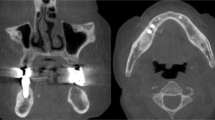Abstract
Sialolithiasis is one of the most common causes of salivary duct obstruction. In the last 20 years, minimally invasive procedures like sialendoscopy, extracorporeal lithotripsy, and basket snaring are increasingly being used for the treatment of salivary gland duct stones. Sialo-irrigation of the salivary gland is an effective procedure for treating inflammation and providing symptomatic relief. This procedure can be employed for the treatment of sialolithiasis using the back pressure of instilled saline. Sialo-irrigation under ultrasound (US) guidance allows for dynamic studies showing real-time images during diagnostic or surgical procedure and can be used for the removal of sialoliths. In addition, it can also be used to remove primitive sialoliths and microliths by washing out the ductal system, which prevents the recurrence of sialoliths. The aim of this study was to propose a minimally invasive technique for sialolithiasis using US-guided sialo-irrigation.





Similar content being viewed by others
References
Beale T, Jawad S. Grainger & Allison’s diagnostic radiology, seventh edition: head and neck radiology/the salivary glands/radiology and pathology/sialolithiasis. Amsterdam: Elsevier Limited; 2021. p. 1620.
Lustmann J, Regev E, Melamed Y. Sialothiasis: a survey on 245 patients and a review of the literature. Int J Oral Maxillofac Surg. 1990;19:135–8.
Baurmash HD. Submandibular salivary stones: current management modalities. J Oral Maxillofac Surg. 2004;62:369–78.
Bodner L, Azaz B. Submandibular sialolithiasis in children. J Oral Maxillofac Surg. 1982;40:55l-l64.
Katz P, Fritsch MH. Salivary stones: innovative techniques in diagnosis and treatment. Curr Opin Otolaryngol Head Neck Surg. 2003;11:173–8.
Marchal F, Dulguerov P, Becker M, Barki G, Disant F, Lehmann W. Specificity of parotid sialendoscopy. Laryngoscope. 2001;111:264–71.
Walvekar RR, Razfar A, Carrau RL, Schaitkin B. Sialendoscopy and associated complications: a preliminary experience. Laryngoscope. 2008;118:776–9.
Lee C, Kim JE, Huh KH, Yi WJ, Heo MS, Lee SS, et al. Therapeutic effect of intraductal irrigation of the salivary gland. A technical report. Imaging Sci Dent. 2017;47:123–7.
Kim JE, Lee SS, Lee C, Huh KH, Yi WJ, Heo MS, et al. Therapeutic effect of intraductal saline irrigation in chronic obstructive sialadenitis. BMC Oral Health. 2020;20:86.
Oh SH, Kang JH, Choi YJ, Kim BY, Lee SR, Lee SH, et al. Ultrasound-guided sialo-irrigation with a saline-air mixture as the contrast medium. Oral Radiol. 2019;35:84–9.
Shin JS, Shim HJ, Kwak BK, Yoon HK. Biliary stone removal through the percutaneous transhepatic biliary drainage route, focusing on the balloon sphincteroplasty flushing technique: a single center study with 916 patients. Jpn J Radiol. 2017;35:440–7.
Panah A, Masood J, Zaman F, Papatsoris AG, El-Husseiny T, Buchholz N. A technique to flush out renal stone fragments during percutaneous nephrolithotomy. J Endourol. 2009;23:5–6.
Im YG, Kook MS, Kim BG, Kim JH, Park YJ, Song HJ. Characterization of a submandibular gland sialolith: micromorphology, crystalline structure, and chemical compositions. Oral Surg Oral Med Oral Pathol Oral Radiol. 2017;124:e13-20.
Antoniades D, Harrison JD, Epivatianos A, Papanayotou P. Treatment of chronic sialadenitis by intraductal penicillin or saline. J Oral Maxillofac Surg. 2004;62:431–4.
Triantafyllou A, Harrison JD, Garrett JR. Analytical ultrastructural investigation of microliths in salivary glands of cat. Histochem J. 1993;25:183–90.
Harrison JD, Epivatianos A, Bhatia SN. Role of microliths in the aetiology of chronic submandibular sialadenitis: a clinicopathological investigation of 154 cases. Histopathology. 1997;31:237–51.
Harrison JD. Causes, natural history, and incidence of salivary stones and obstructions. Otolaryngol Clin North Am. 2009;42:927–47.
Grases F, Santiago C, Simonet BM, Costa-Bauzt A. Sialolithiasis: mechanism of calculi formation and etiologic factors. Clin Chim Acta. 2003;334:131–6.
Koutsoukos PG, Nancollas GH. Crystal growth of calcium phosphates: epitaxial considerations. J Cryst Growth. 1981;53:10–9.
Yamamoto H, Sakae T, Takagi M, Otake S. Scanning electron microscopic and X-ray microdiffractometeric studies on sialolith-crystals in human submandibular glands. Acta Pathol Jpn. 1984;34:47–53.
Witt RL, Iro H, Koch M, McGurk M, Nahlieli O, Zenk J. Minimally invasive option for salivary calculi. Laryngoscope. 2012;122:1306–11.
Luers JC, Grosheva M, Reifferscheid V, Stenner M, Beutner D. Sialoendoscopy in sialolithiasis: early treatment, better outcome. Head Neck. 2012;34:499–504.
Marchal F, Dulguerov P. Sialolithiasis management: the state of the art. Arch Otolaryngol Head Neck Surg. 2003;129:951–6.
Szabo TL, Lewin PA. Ultrasound transducer selection in clinical imaging practice. J Ultrasound Med. 2013;32:573–82.
Author information
Authors and Affiliations
Corresponding author
Ethics declarations
Conflict of interest
Eun Mi Kim, Sung Hyun Lee, Song Hee Oh, Gyu-Tae Kim, Yong-Suk Choi and Eui-Hwan Hwang declares that they have no conflict of interest.
Ethical approval
All procedures followed were in accordance with the ethical standards of the responsible committee on human experimentation (institutional and national) and with the Helsinki Declaration of 1975, as revised in 2008 (5).
Informed consent
Informed consent was obtained from all patients for being included in the study.
Additional information
Publisher's Note
Springer Nature remains neutral with regard to jurisdictional claims in published maps and institutional affiliations.
Rights and permissions
About this article
Cite this article
Kim, E.M., Lee, S.H., Oh, S.H. et al. Ultrasound-guided sialo-irrigation for the treatment of chronic sialodochitis with sialolithiasis. Oral Radiol 37, 345–351 (2021). https://doi.org/10.1007/s11282-020-00495-2
Received:
Accepted:
Published:
Issue Date:
DOI: https://doi.org/10.1007/s11282-020-00495-2




